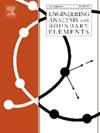The RBF-FD method for solving the time-fractional viscoelastic wave propagation in irregular domains
IF 4.2
2区 工程技术
Q1 ENGINEERING, MULTIDISCIPLINARY
Engineering Analysis with Boundary Elements
Pub Date : 2025-02-08
DOI:10.1016/j.enganabound.2025.106121
引用次数: 0
Abstract
The time-fractional viscoelastic wave equation plays a crucial role in geophysical exploration by accurately modeling wave attenuation and velocity dispersion in Earth’s media. However, solving this equation is challenging due to the stress–strain relationship governed by the Caputo fractional derivative of small orders and the complexity of irregular surface topographies. The requirement for significant memory and computational resources when dealing with small fractional orders limits the efficiency of traditional methods. Conventional approaches, which rely on horizontal reference planes, fixed-step grids, and stair-step approximations for irregular surfaces, often lead to staircase scattering and reduced accuracy. To address these challenges, this study proposes a numerical algorithm based on the Radial Basis Function-Finite Difference (RBF-FD) method for simulating time-fractional viscoelastic waves in irregular domains. The meshless nature of the RBF-FD method allows for flexible node distribution, making it well-suited for complex interfaces. Additionally, a short-memory algorithm is implemented to efficiently solve the stress–strain relationship governed by the fractional derivative. Several numerical experiments are presented to validate the accuracy and efficiency of the proposed scheme.
求解不规则区域时间分数黏弹性波传播的RBF-FD方法
时间分数型粘弹性波动方程准确模拟了地球介质中的波衰减和速度频散,在地球物理勘探中起着至关重要的作用。然而,由于小阶的Caputo分数阶导数控制的应力-应变关系和不规则表面地形的复杂性,求解该方程具有挑战性。在处理小分数阶时对大量内存和计算资源的需求限制了传统方法的效率。传统的方法依赖于水平参考面、固定步进网格和不规则表面的阶梯近似,经常导致阶梯散射和精度降低。为了解决这些挑战,本研究提出了一种基于径向基函数-有限差分(RBF-FD)方法的数值算法,用于模拟不规则区域的时间分数粘弹性波。RBF-FD方法的无网格特性允许灵活的节点分布,使其非常适合复杂的接口。此外,为了有效地求解分数阶导数控制下的应力-应变关系,采用了短时记忆算法。通过数值实验验证了该方法的准确性和有效性。
本文章由计算机程序翻译,如有差异,请以英文原文为准。
求助全文
约1分钟内获得全文
求助全文
来源期刊

Engineering Analysis with Boundary Elements
工程技术-工程:综合
CiteScore
5.50
自引率
18.20%
发文量
368
审稿时长
56 days
期刊介绍:
This journal is specifically dedicated to the dissemination of the latest developments of new engineering analysis techniques using boundary elements and other mesh reduction methods.
Boundary element (BEM) and mesh reduction methods (MRM) are very active areas of research with the techniques being applied to solve increasingly complex problems. The journal stresses the importance of these applications as well as their computational aspects, reliability and robustness.
The main criteria for publication will be the originality of the work being reported, its potential usefulness and applications of the methods to new fields.
In addition to regular issues, the journal publishes a series of special issues dealing with specific areas of current research.
The journal has, for many years, provided a channel of communication between academics and industrial researchers working in mesh reduction methods
Fields Covered:
• Boundary Element Methods (BEM)
• Mesh Reduction Methods (MRM)
• Meshless Methods
• Integral Equations
• Applications of BEM/MRM in Engineering
• Numerical Methods related to BEM/MRM
• Computational Techniques
• Combination of Different Methods
• Advanced Formulations.
 求助内容:
求助内容: 应助结果提醒方式:
应助结果提醒方式:


